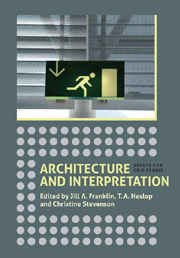Book contents
- Frontmatter
- Contents
- List of Illustrations
- Preface: In Appreciation
- List of contributors
- 1 Introduction
- Incitements to Interpret in Late Antique and Medieval Architecture
- Authors and Intentions
- 146 Home Sweet Mammoth: Neuroarchaeology and the Origins of Architecture
- 163 Constantine and Helena: The Roman in English Romanesque
- 176 For Their Monuments, Look about You: Medieval Masons and their Tombs
- 192 Baxandall's Bridge and Charles IV's Prague: An Exercise in Architectural Intention
- 221 Imitation as a Creative Vehicle in Michelangelo's Art and Architecture
- 242 The ‘Façade Problem’ in Roman Churches, c. 1540–1640
- Architecture beyond Building
- Index
242 - The ‘Façade Problem’ in Roman Churches, c. 1540–1640
from Authors and Intentions
Published online by Cambridge University Press: 05 April 2013
- Frontmatter
- Contents
- List of Illustrations
- Preface: In Appreciation
- List of contributors
- 1 Introduction
- Incitements to Interpret in Late Antique and Medieval Architecture
- Authors and Intentions
- 146 Home Sweet Mammoth: Neuroarchaeology and the Origins of Architecture
- 163 Constantine and Helena: The Roman in English Romanesque
- 176 For Their Monuments, Look about You: Medieval Masons and their Tombs
- 192 Baxandall's Bridge and Charles IV's Prague: An Exercise in Architectural Intention
- 221 Imitation as a Creative Vehicle in Michelangelo's Art and Architecture
- 242 The ‘Façade Problem’ in Roman Churches, c. 1540–1640
- Architecture beyond Building
- Index
Summary
Although the façade of the church is quite beautiful and all of travertine … nevertheless the church (although adorned with ten side chapels and two larger transept chapels, besides the high altar and the chapel of S. Philip all of rare stones, and all with paintings by the most famous painters of our time) could be of better design and architecture.
Because the Oratory is the son of the Church, and through Confession and frequenting the Sacraments many are inspired to come to the Oratory, it was thought a good idea that the Oratory façade should be like a daughter to the façade of the church.
THE FRONT, or principal elevation, of a building may represent the character of its interior; alternatively it may express its character or its function, for example the urban cinema of the 1930s as a place of dreams and fantasy. Or it may do neither, whether because nobody thought that it mattered or – a fourth alternative – because the architect set out, for aesthetic reasons, deliberately to mislead. Of the two façades compared in the epigraph and illustrated in fig. 1, that on the right, of the Chiesa Nuova (S. Maria in Vallicella), Rome, has more to do with expression than with representation, because it is considerably larger than the cross-section of the building behind it. That on the left is, in its architect's own description, an expression as well as, in another phrase, a device ‘to deceive the eye of the passer-by’.
- Type
- Chapter
- Information
- Architecture and InterpretationEssays for Eric Fernie, pp. 242 - 264Publisher: Boydell & BrewerPrint publication year: 2012



